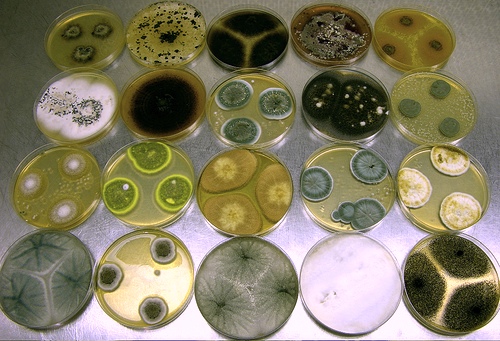High ambient moisture increases the growth of problematics molds. They often cause allergy, but also cause morbidity via release of VOCs toxins (even in the absence of allergy).
Dampness in living and work environments is associated with respiratory health problems. Dry it out, and problems get better.
Long-term exposure to indoor molds is associated with higher risk of symptoms than short-term exposure.
Indoor mold control includes mitigation of facilitating factors (food, water, warmth, shelter).
Stachybotrys ("toxic black mold") requires an extremely damp environment for growth. Aspergillus and Penicillium, less so.
Concrete is generally inhospitable to mold growth. Houses today are so "tight", that it can be difficult to have a source of fresh air intake. This is problematic.

Various fungi including Penicillium and Aspergillus spp. growing in axenic culture. Image source: Wikipedia, Dr. David Midgley Cultures: Dr. David Midgley University of Sydney, Australia, Creative Commons Attribution ShareAlike 2.5 License.
There is a significant association of mold and respiratory problems in pre-exisiting asthma. There is almost enough evidence to establish causation of new onset asthma.
Environmental assessment and remediation should be standardized, and become a mainstream part of high quality medical care.
Brett Green discussed exposure assessment for indoor mold and remediation.
Fungal contamination in U.S. buildings is becoming an increasing concern. Traditional methods of assessment date back to 19th century.
Fungal detection and quantification methods include:
- traditional methods: culture, morphology
- modern methods: antigen, biomass, DNA
A combination of these approaches has been developed including halogen immunoassay:
- collect from environment
- immuno-stain
Microarrays and macroarrays are becoming available for identification of fungi.
In indoor environment, Aspergillus species is well-represented, also Cladosporium and many other fungi.
Tina Reponen discussed indoor mold and asthma onset in children.
Qualitative methods of assessing mold exposure include visible water damage, visible mold, moldy odor.
A study evaluated association between mold exposure and asthma in children from ages 1-7 years. It included a questionnaire, home walk through, and sampling. Visible mold was number two risk factor for wheezing at age 1 year, after maternal smoking. Visible mold at age 1 year remained a risk factor for wheezing at age 3 yrs. Interestingly, mold sensitization was not associated with asthma at age 7 yrs.
Air conditioning at 1 year was inversely correlated with asthma at age 7 yrs (protective effect).
Allergists achieved highest use of social media by any specialty
During the 2012 AAAAI meeting, the allergists achieved the highest use of social media by any specialty. There are more than 100 allergists on Twitter and 30 of them posted simultaneously from the annual meeting, broadcasting thousands of tweets tagged with #AAAAI. The annual AAAAI meeting was attended by approximately 5,000 people. In comparison, the 30 allergists on Twitter reached 250,000 people (measured by TweetReach.com on 03/04/2012).
This summary was compiled from some of the tweets posted by Sakina Bajowala, M.D @allergistmommy. I would strongly encourage you to post updates on Twitter from the CME conferences that you are planning to attend in the future. Here is how to do it: Twitter for Physicians: How to use Twitter to keep track of the latest news and scientific meetings, and share information with colleagues and patients.
Disclaimer: The text was edited, modified, and added to by me. This is one of a series of posts that will be published during the next few weeks.
Related:
Immunotherapy to molds - the only two molds which have been studied extensively are Alternaria and Cladosporium http://buff.ly/VkpH8Y